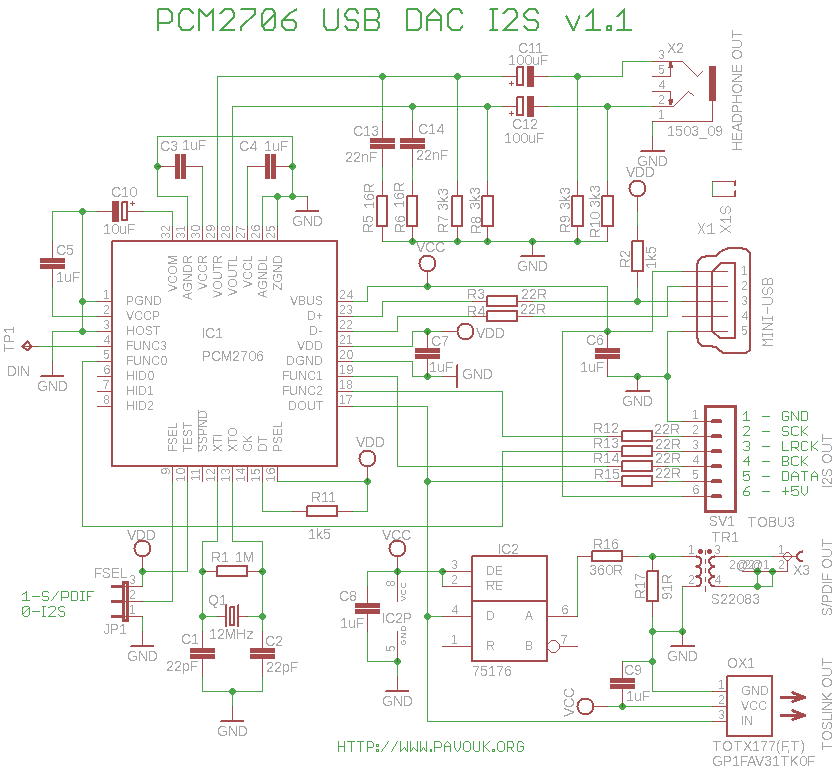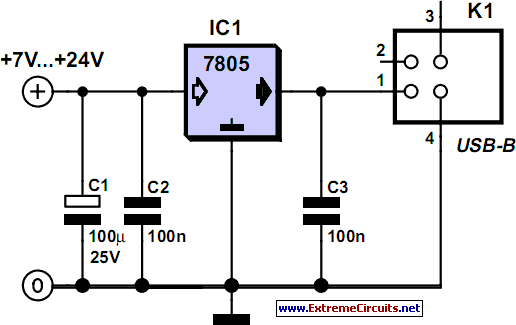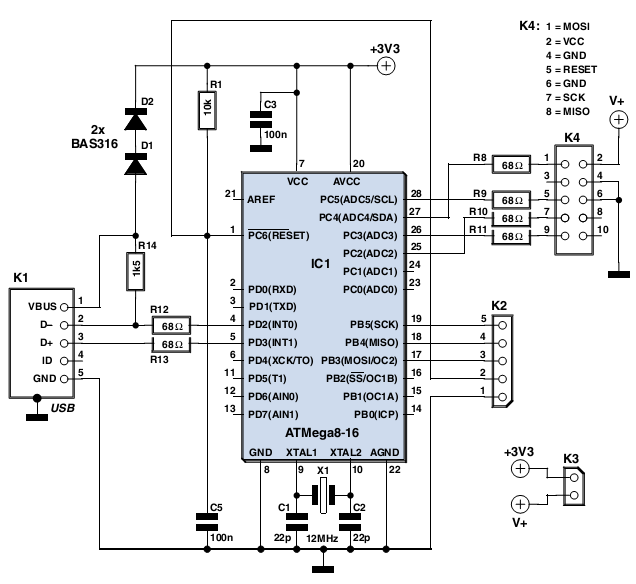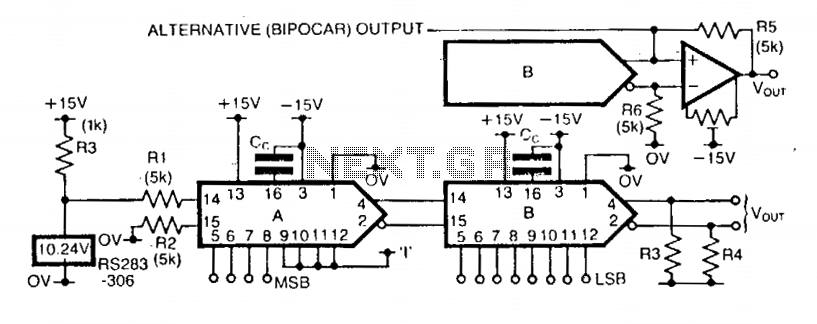
PCM2706 USB DAC with I2S

This project involves a couple of USB Digital-to-Analog Converters (DACs) that lack I2S output. Some users do not require S/PDIF input and prefer a direct USB connection. Therefore, it is unnecessary to convert the signal from USB to S/PDIF and then to I2S for the DAC. This board features an analog headphone output, galvanically isolated S/PDIF output, and optical TOSLINK output. By switching a jumper circuit, the board can operate in I2S mode, allowing direct connection to a DAC. The schematic utilizes the PCM2706 circuit from Texas Instruments, which includes a Digital/Analog converter, S/PDIF output, I2S output, and a Human Interface Device (HID) interface for push buttons. The schematic diagram is similar to the recommended configuration in the datasheet. The USB input is equipped with a standard miniUSB connector. The PCM2706 circuit has an integrated headphone amplifier, with its output passing through an external low-pass filter to a standard 3.5mm jack socket. The circuit incorporates digital volume control ranging from 0 dB to -64 dB in 1 dB steps, which only affects the analog output and does not influence the I2S and S/PDIF outputs. In S/PDIF mode (FSEL=1), the S/PDIF data output is active, and the FUNC0 to FUNC3 pins serve as inputs for unused push buttons. The S/PDIF output connects to an optical transmitter and an RS485 driver, which boosts the signal to a voltage divider, reducing the signal to approximately 1 volt and adjusting the output impedance to about 75 ohms. The signal is galvanically isolated using a pulse transformer. In I2S mode (FSEL=0), the DOUT data is transmitted in I2S format (16 bits left justified), with LRCK, BCK, and SYSCK signals on FUNC0 to FUNC2 pins. The FUNC3 pin serves as the I2S data input signal connected to the internal DAC. In the current circuit, this is only available at the test point, and the headphone output remains silent in this mode. To activate the headphone output in I2S mode, it can be connected to DOUT, which is intended for use with sound effects from an external DSP. The I2S output is not isolated; therefore, an external isolator is required for galvanic isolation. The schematic is also compatible with the PCM2707 circuit, as all connection requirements for both chips have been maintained. This has not been tested due to the unavailability of the PCM2707 chip. Components are arranged on the board from smallest to largest, starting with integrated circuits, followed by other SMD components. The assembly progresses from the top side with wire wraps and connectors. If the analog output is not required, the analog filter and jack connector components do not need to be assembled. Similarly, if the electrical S/PDIF output is unnecessary, components IC2, R16, R17, TR1, and X3 can be omitted. The optical output requires only C9 and OX1. The printed circuit board is single-sided, facilitating creation under amateur conditions. SMD components are placed on the bottom side, while parts with wires, wire wraps, and connectors are positioned on the top side. The board dimensions were slightly modified in version 1.1 to allow for direct connection with DAC boards, enabling connectors to be aligned on the back panel.
The circuit design centers around the PCM2706, which integrates a USB interface, a DAC, and an S/PDIF output. The digital volume control feature enhances user experience by allowing precise adjustment of sound levels through the analog output, while ensuring that the digital outputs remain unaffected. The galvanic isolation of the S/PDIF output is critical in preventing ground loops and ensuring signal integrity, especially when interfacing with other audio equipment.
The PCB layout emphasizes ease of assembly and flexibility. The decision to place SMD components on the bottom side while leaving the top side for wire wraps and connectors is strategic, allowing for easier soldering and maintenance. The modular approach to component assembly ensures that users can customize the board according to their specific needs, omitting unnecessary parts based on the desired functionality.
The inclusion of both S/PDIF and I2S outputs caters to a wide range of audio applications, from basic headphone amplification to more complex setups involving external DSPs. The careful consideration of signal paths, isolation, and component placement demonstrates a thorough understanding of audio circuit design principles, ensuring a reliable and high-quality audio output.A couple of USB DACs but no one have I2S output. Some people doesn`t need S/PDIF input and they want only USB. With these requirements is unnecessary to convert signal first from USB to S/PDIF and next to I2S for DAC. This board have analog headphone output, electric galvanically isolated S/PDIF output and optical TOSLINK.
After switching jumper circuit switch to I2S mode, which can be directly connected to DAC. Diagram use PCM2706 circuit from Texas Instruments. Circuit includes Digital/Analog converter, S/PDIF output, I2S output and HID interface for push buttons. Schematics diagram is similar to recommended diagram in datasheet. USB input has standard miniUSB connector. Circuit PCM2706 has integrated headphone amplifier and his output goes through external low-pass filter to standard 3.
5" jack socket. Circuit includes digital volume control in a range 0dB to -64dB with 1dB step. This control works only with analog output. It doesn`t have effect for I2S and S/PDIF outputs. In S/PDIF mode (FSEL=1) is active S/PDIF data output and on pins FUNC0 to FUNC3 are inputs for push buttons, which are not used. S/PDIF output goes to optical transmitter and to RS485 driver which boosts signal to voltage divider which divide signal approximately to 1 volt and adjust output impedance to about 75 ohms.
Signal is galvanically isolated by pulse transformer. In I2S mode (FSEL=0) goes to the DOUT data in I2S format (16 bits left justified) and on pins FUNC0 to FUNC2 are LRCK, BCK and SYSCK signals. On the pin FUNC3 is now I2S data input signal which is connected to the internal DAC. In my circuit is only on the testpoint and headphone output is silent in this mode. If you want to have active this output in I2S mode, that you can connect it with DOUT. This functionality is described for use with sound effects with external DSP. I2S output is not isolated that if you want them galvanically isolate you must use external isolator.
Schematics should work with PCM2707 circuit too, because I keeped all connection requirements for both chips. This was not tested because I hadn`t this chip available. We place components on the board from smaller to bigger. We begin with integrated circuits and next continue with other SMD components. Next we continue from a top side with wire wraps and other components. Last we assemble connectors. If you don`t want to use for example analog output, that you don`t need assemble parts of analog filter and jack connector.
If you don`t want electrical S/PDIF output that don`t assemble IC2, R16, R17, TR1 and X3. Optical output includes only C9 and OX1. Printed circuit board is single-sided which allows to create him in amateur conditions. SMD components are from a bottom side and parts with wires, wire wraps and connectors from a top side. Board dimensions was changed a little in a 1. 1 version for direct connection with DAC boards. It allows to have connectors on a back panel with boards in one line. 🔗 External reference
The circuit design centers around the PCM2706, which integrates a USB interface, a DAC, and an S/PDIF output. The digital volume control feature enhances user experience by allowing precise adjustment of sound levels through the analog output, while ensuring that the digital outputs remain unaffected. The galvanic isolation of the S/PDIF output is critical in preventing ground loops and ensuring signal integrity, especially when interfacing with other audio equipment.
The PCB layout emphasizes ease of assembly and flexibility. The decision to place SMD components on the bottom side while leaving the top side for wire wraps and connectors is strategic, allowing for easier soldering and maintenance. The modular approach to component assembly ensures that users can customize the board according to their specific needs, omitting unnecessary parts based on the desired functionality.
The inclusion of both S/PDIF and I2S outputs caters to a wide range of audio applications, from basic headphone amplification to more complex setups involving external DSPs. The careful consideration of signal paths, isolation, and component placement demonstrates a thorough understanding of audio circuit design principles, ensuring a reliable and high-quality audio output.A couple of USB DACs but no one have I2S output. Some people doesn`t need S/PDIF input and they want only USB. With these requirements is unnecessary to convert signal first from USB to S/PDIF and next to I2S for DAC. This board have analog headphone output, electric galvanically isolated S/PDIF output and optical TOSLINK.
After switching jumper circuit switch to I2S mode, which can be directly connected to DAC. Diagram use PCM2706 circuit from Texas Instruments. Circuit includes Digital/Analog converter, S/PDIF output, I2S output and HID interface for push buttons. Schematics diagram is similar to recommended diagram in datasheet. USB input has standard miniUSB connector. Circuit PCM2706 has integrated headphone amplifier and his output goes through external low-pass filter to standard 3.
5" jack socket. Circuit includes digital volume control in a range 0dB to -64dB with 1dB step. This control works only with analog output. It doesn`t have effect for I2S and S/PDIF outputs. In S/PDIF mode (FSEL=1) is active S/PDIF data output and on pins FUNC0 to FUNC3 are inputs for push buttons, which are not used. S/PDIF output goes to optical transmitter and to RS485 driver which boosts signal to voltage divider which divide signal approximately to 1 volt and adjust output impedance to about 75 ohms.
Signal is galvanically isolated by pulse transformer. In I2S mode (FSEL=0) goes to the DOUT data in I2S format (16 bits left justified) and on pins FUNC0 to FUNC2 are LRCK, BCK and SYSCK signals. On the pin FUNC3 is now I2S data input signal which is connected to the internal DAC. In my circuit is only on the testpoint and headphone output is silent in this mode. If you want to have active this output in I2S mode, that you can connect it with DOUT. This functionality is described for use with sound effects with external DSP. I2S output is not isolated that if you want them galvanically isolate you must use external isolator.
Schematics should work with PCM2707 circuit too, because I keeped all connection requirements for both chips. This was not tested because I hadn`t this chip available. We place components on the board from smaller to bigger. We begin with integrated circuits and next continue with other SMD components. Next we continue from a top side with wire wraps and other components. Last we assemble connectors. If you don`t want to use for example analog output, that you don`t need assemble parts of analog filter and jack connector.
If you don`t want electrical S/PDIF output that don`t assemble IC2, R16, R17, TR1 and X3. Optical output includes only C9 and OX1. Printed circuit board is single-sided which allows to create him in amateur conditions. SMD components are from a bottom side and parts with wires, wire wraps and connectors from a top side. Board dimensions was changed a little in a 1. 1 version for direct connection with DAC boards. It allows to have connectors on a back panel with boards in one line. 🔗 External reference





